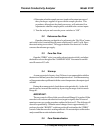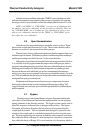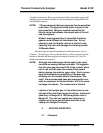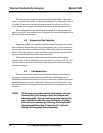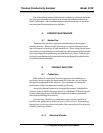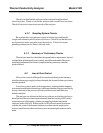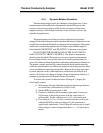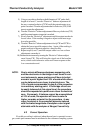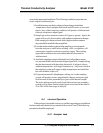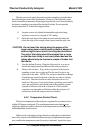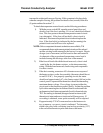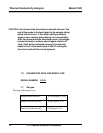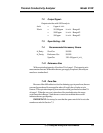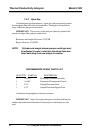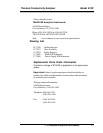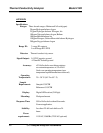
Teledyne Analytical Instruments
22
Thermal Conductivity Analyzer Model 212R
Check as previously stated, the analyzers entire sampling system has been
checked under pressure with a leak detector. However, if the external system
checks out and the instrument is displaying a large diurnal or uni- directional drift,
the interior sampling system should be checked for leaks. Do not open the
analyzer inner door. Use the following procedure:
1) Acquire a source of cylinder helium and through a dual stage
regulator connect it to a length of 1/8" tubing.
2) Open the outer door of the analyzer and insert the tubing be-
tween the edge of the sample control panel and the outer case.
CAUTION: Do not insert the tubing along the edges of the
larger swing-down control panel as there is danger of
obstructing the fan or short circuiting the electronics.
The end of the tubing should be shaped into a curve
so that the foam lining is not overly disturbed and the
tubing should only be inserted a couple of inches into
the interior.
3) Start the helium flowing. Keep the flowrate low so as not to
disturb the temperature equilibrium of the analyzer interior.
4) Observe the recorder. If any leaks are present in the interior
sampling system, the recorder will be driven off scale in one
direction or the other. NOTE: The analyzer should be on Range
#1 and the zero control adjusted so that the recorder is reading
mid-scale. The direction the recorder indication moves is a
function of the type of zero and reference gas being used (which
varies per application) and which path of the sampling system
(sample or reference) the leak is located in. If the recorder
responds to an atmosphere of helium within the analyzer, all
connections inside the analyzer must be checked.
6.4.2 Temperature Control Check.
The interior temperature of the analyzer is regulated to a constant value to
within .002 degrees centigrade. The actual temperature control point
varies
slightly per application and is a function of the components used in the propor-
tional temperature control circuit.
If the recorder is displaying a large diurnal recording that is related to the
time of day in terms of the differential between day and night ambient tempera-
ture, trouble in the temperature control circuitry is indicated. Again, this symp-



